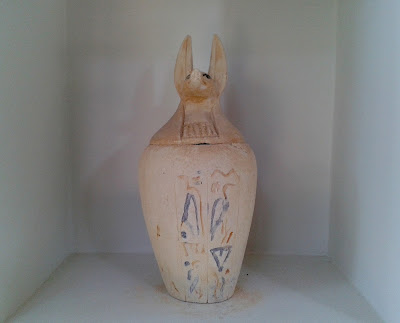A CASA NOSTRA hi ha... quatre vasos canopis.
Avui tornem a fer un viatge al passat, encara més enrere en el temps que no pas ahir, fins a l'Antic Egipte. A casa nostra hi ha quatre vasos canopis que vam portar d'un viatge impressionant pel Nil l'any 2005. Sense que es trenquessin a les maletes! Today we take again a trip to the past, even further back in time than yesterday, to the Ancient Egypt. At home, we gave four canopic jars that we bought on an amazing cruise by the Nile.
Els vasos canopis eren emprats a l'Antic Egipte pels embalsamadors per a dipositar-hi les vísceres del difunt (l'estòmac, el fetge, els intestins i el pulmons) perquè les necessitaria en l'altra vida. Normalment estaven fets d'alabastre, però també n'hi havia de fusta, de guix o de ceràmica. Des de l'Imperi Nou, als vasos canopis s'hi representaven els caps dels quatre fills d'Horus, ja que es considerava que cadascun d'ells protegia l'organ corresponent. Canopic jars were used by the Ancient Egyptians during the mummification process to store and preserve the viscera of their owner for the afterlife. They were commonly either carved from limestone or were made of pottery. The canopic jars were four in number, each for the safekeeping of particular human organs: the stomach, intestines, lungs, and liver, all of which, it was believed, would be needed in the afterlife. By the late Eighteenth dynasty canopic jars had come to feature the four sons of Horus.
Així, Duamutef, que es representava amb forma de xacal, guardava l'estòmac (el protegia la deesa Neith i la seva posició era mirant en direcció oest)... Amset, amb forma de cap humà, guardava el fetge (el protegia Isis, i estava orientat al sud)... Kebehsenuf, amb forma de cap de falcó, guardava els intestins (estava protegit per la deesa Selkis, i mirava cap a l'oest)... i Hapi, que tenia la forma d'un cap de babuí, guardava els pulmons (i estava protegit per la deesa Neftis i mirava al nord). Tots quatre s'introduïen en una caixa de fusta, i es col·locaven al costat o als peus del sarcòfag per a protegir el difunt. Each god was responsible for protecting a particular organ, and was himself protected by a companion goddess. They were: Duamutef, the jackal-headed god representing the east, whose jar contained the stomach and was protected by the goddess Neith... Imseti, the human-headed god representing the south, whose jar contained the liver and was protected by the goddess Isis... Qebehsenuef, the falcon-headed god representing the west, whose jar contained the intestines and was protected by the goddess Selket... Hapi, the baboon-headed god representing the north, whose jar contained the lungs and was protected by the goddess Nephthys.
 |
| src historia y arqueologia |
Vam comprar aquests vasos canopis en una petita botiga, digue'm-ne de souvenirs, de Luxor, amb molt d'encant perquè semblava treta d'una pel·lícula antiga d'arqueòlegs... tot ben rònec, ple de pols i amuntegat, però les imitacions estaven molt ben fetes. No era, en absolut, la típica botiga del centre, prop dels hotels i les vies més comercials. Per això, i perquè ens agraden molt, ens va semblar bé comprar-hi aquests vasos canopis, que s'assemblen molt als de veritat (les figures dels caps dels vasos i les mides generals no són extrafetes com en d'altres còpies) i el preu no era exagerat. Ara, cada un d'ells té la seva urna a la nostra casa de la muntanya. We bought these canopic jars in a small and charming shop of souvenir in Luxor... a very barren and dustyshop, but the imitations were very well done. It was quite far from hotels and commercial areas. For this reason, and because we like them a lot, it seemed to us good to buy these canopic jars, which look just like the real (the heads of the figures and vessels sizes are quite similars to originals, except for the writings) and the price was not excessive. Now, they are at our countryside house.
Nauttikaa! Gaudiu_Enjoy!
MOI, MOI!






Cap comentari:
Publica un comentari a l'entrada